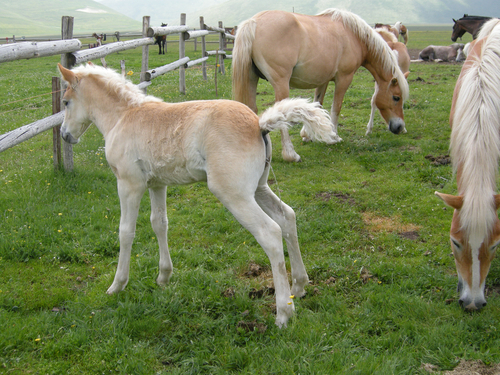Management of horse pasture is an ongoing process that takes time, equipment, knowledge, and dollars. If managed wisely and well, pasture will be an economical source of high-quality feed as well as a healthy place for horses to exercise.

Horse pasture - Springtime management decisions
Management of a horse pasture is an ongoing process, and if managed wisely, it will be an economical source of high-quality feed as well as a healthy place for horses to exercise.
If managed poorly or ignored, pasture can soon become nothing more than an overgrazed weed patch that not only has little nutritional value, but may contribute to horse health problems.
Basic pasture-planning decisions:
- The nutritional role of your pasture acreage whether it's to be a major feed source or just an exercise lot
- Options for pasture improvement-whether to renovate, reestablish, or merely maintain.
- Step- by-step procedures for renovating or reestablishing an existing pasture, and for establishing a new one.
- Practices that help maintain and extend pasture productivity.
Usage decision: Nutrition or exercise only for your horse:
The first decision is whether to use the pasture for exercise purposes only or as a major part of your nutritional program. Most horses benefit from being outside regularly to exercise. This need can be met on relatively small, well-drained lots. Free exercise reduces behavior and respiratory problems, improves bone growth, and increases vitamin metabolism.
If your desire, however, is for the pasture to serve as a feed source, other factors need to be considered including its potential nutritional value and its carrying capacity.
Pasture nutritional value. Most horses can be maintained nutritionally through the growing season on well-managed pasture if provided with fresh water and a supply of trace-mineralized salt. Productive pasture during the growing season can replace hay and reduce the concentrate required by most horses, and can replace all feed for those that are laid up, mature, idle, or pregnant. Lactating mares and fast-growing weanlings will probably need additional energy, protein, and minerals.
Management practices need to be utilized that keep the forage actively growing. The key to nutritional management is to continually observe the horses and supplement the pasture only if the horses' body condition so indicates.
Horses should consume 1 percent or more of their body weight per day in forage dry-matter. If the major nutrient source is pasture, a 1000-pound horse will collectively consume and waste approximately 3 tons of forage dry matter during a typical 6-month grazing season. With average management, it would take about 2 acres of pasture to meet the nutrient needs of a mature horse.
Of course, the carrying capacity of any particular pasture will depend on such things as type of horses, soil type, soil fertility, drainage conditions, amount of rainfall, time of year, and type of forage species present. For instance, in mid- to late-summer or in droughty periods, grass-only pastures will not carry as many horses as grass-legume pastures. Many annual forage species can be planted to provide supplemental feed in times of short permanent pasture supply.For many horse owners, purchasing hay is a more economical solution to the crisis.
Improvement: Renovate, reestablish, or leave it alone?
If the pasture is predominantly a place for horses to exercise and the stocking rate averages more than one 1000-pound horse per acre, it should probably be left alone. Under high stocking rates, forage crops will always lack vigor and never have the opportunity to attain their production potential. Areas that will remain exercise lots and that have an adequate sod cover should not be considered for major overhaul, since improvement costs will likely exceed any realized benefits.
If, on the other hand, the pasture is to be an important feed source but is currently unimproved and overstocked, then renovation or reestablishment is justified, provided improved pasture management practices will be employed to maintain it.
When a pasture is renovated, it is "renewed" through a set of proven management practices that usually include controlling weeds, liming and fertilizing according to soil test, reducing vigor of the existing sod, then seeding into that sod an adapted legume or grass-legume mixture. When a pasture is reestablished, the existing vegetation is completely destroyed by tillage or a herbicide, the soil is limed and fertilized (again according to soil test), then a seedbed is prepared and planted with adapted forage species.
Reestablishment is usually more costly than renovation, since it involves additional tillage or herbicide use. However, the extra expense may be justified if a higher-yielding forage is desired (e.g., smooth bromegrass to replace Kentucky bluegrass) or if the existing pasture is predominately bare ground, or weeds with little sod cover beneath.
Localized high-traffic areas near the water supply and gates might also be reestablished to tall fescue, which is better able to withstand heavy trampling.
Renovating grass pasture without legumes:
Often the best way of renovating grass pasture is to introduce an adapted legume into the existing sod. Sometimes, however, this is not possible because grazing pressure would be too intense for legume survival or because inaccessibility to water would make rotational grazing impractical. Thus, pasture improvement has to be accomplished without the benefit of legumes.
The recommended way to improve a grass pasture involves a sequence of practices including weed control, soil testing, liming, fertilizing, and grazing management.
Controlling Weeds
The presence of weeds and brush in a pasture often indicates poor management, particularly over-grazing and inadequate fertilization. If broadleaf weeds are a problem, control with herbicides may be necessary. Herbicides will kill any legumes present. Therefore, if the pasture contains legumes that are making a contribution, apply the herbicides only to the severely weed-infested areas.
After weeds and brush are controlled, proper pasture management practices must be used or the weeds and brush will reappear.
Information from: Maximizing the Value of Pasture for Horses, Purdue University
